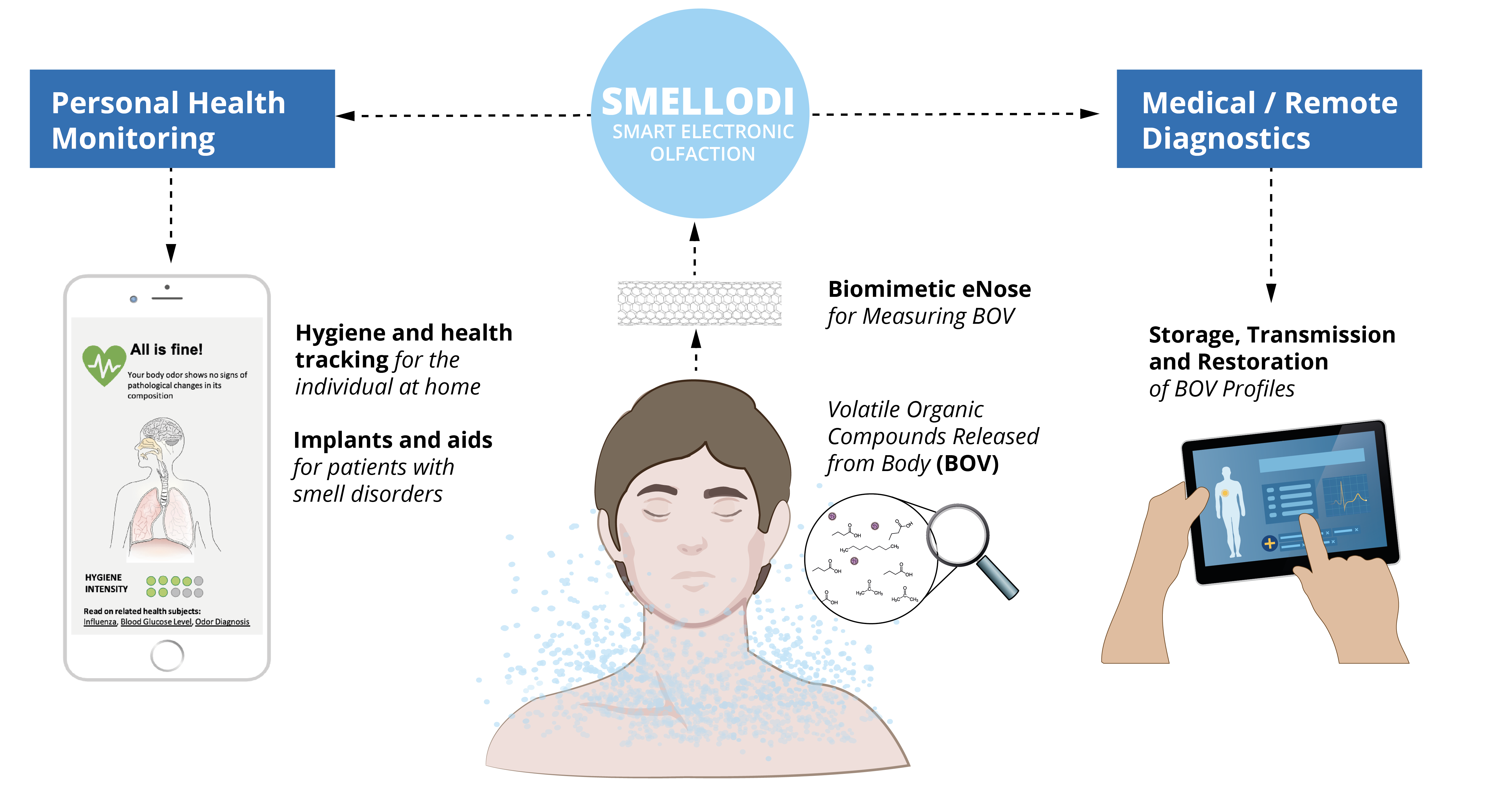Background: Smart electronic olfaction for body odor diagnostics
While almost everyone nowadays has a smartphone that can recognize faces and objects in pictures taken by the in-built camera, responds to our voice input, and interprets touch, by far no such functionality is available for interpreting our chemical environment. In many ways, this is a severe limitation since olfaction plays an important role in our daily life, for personal interactions, and for professional work. Although electronic noses (eNoses) based on different technologies are widely available and used for many purposes already, a true breakthrough in digitizing the sense of smell is still pending and depends on both an electronic equivalent to the olfactory system and an intelligent interpretation of the resulting signals, paralleling the cognitive processes involved in human odor perception.
Role of olfaction in health-care
A significant application area of innovation in smart electronic olfaction technology is healthcare. Already the ancient Greeks recognized the importance of odors emitted from the body (the volatilome, BOV) as important cues for the detection of illnesses. Some pathological changes of the BOV can be perceived by medical personnel such as the smell of an infected wound. There are even examples of “super-smelling” individuals who can diagnose Parkinson’s disease or inflammations from BOV [1]. An eNose trained to distinguish healthy and pathological odors gives rise to a completely new field in medical diagnostics. Technologies enhancing the visual or auditory domain, such as ultrasound, endoscopy, or microscopy of blood or urine samples, and lab-base36/d chemical analyses enable the storage and passing on of the collected patient data. Similar enhancements, such as storage, transmission, and restoration are not yet possible for olfactory information. Smart electronic olfaction will make valuable information – mostly unexploited by physicians today – available and interpretable. Our envisioned technology of electronic BOV recognition has the potential to become a fast, immediate and non-invasive diagnostic tool that allows long-term monitoring of BOVs. A new form of remote diagnostics will be established by the development of an innovative odor display device, which enables the transmission and reproduction of BOVs for further inspection of enhanced odor profiles or for the calibration of medical eNoses. With the emergence of cheap, environment-friendly, and biocompatible sensor devices, health monitoring of BOVs may transform complicated or painful procedures used in specialized hospitals to a non-exclusive technology for the individual.
Body Odors‘ Importance
Body odors also play a subtle, but crucial role in many social situations. They influence attraction to our partner, build a sense of belonging in the family and allow drawing conclusions about emotions or illness of our fellow human beings [2]. Therefore, the inability to perceive one’s own and others‘ body odor is described as one of the most severe impairments for people with olfactory disorders, as maintaining personal hygiene is difficult, and important cues in social interactions are missing [3]. Decreased olfaction occurs in nearly 20% of the population, and the importance of our sense of smell has recently received special attention with the large number of people who experience temporary loss or impairment of olfactory function due to COVID-19 disease. An electronic olfaction device that is sensitive to changes in BOVs, can be used to facilitate implants and aids for patients with smell disorders to improve their quality of life.
smellodi’s technology
The technology developed in smellodi has long-term implications for much broader areas of olfactory-based assessments. The digitization of olfaction would have an immediate and transformative impact on society and industry. Electronic olfaction will shape the next generation Smart Home, e.g., with fridges that monitor the quality of food, improve industrial processes, such as using robots that indicate possible malfunctions, and enhance safety and environmental monitoring. The market perspectives for this technology are huge, reaching from mass-market personal devices to highly specialized diagnostic tools.
- Trivedi, D.K., et al. ACS Cent Sci, 2019. 5(4).
- Schäfer, L., et al. Phil. Trans. Royal Society B, 2020. 375(1800).
- Hummel, T., et al. Rhinology. Supplement, 2017. 54(26).




